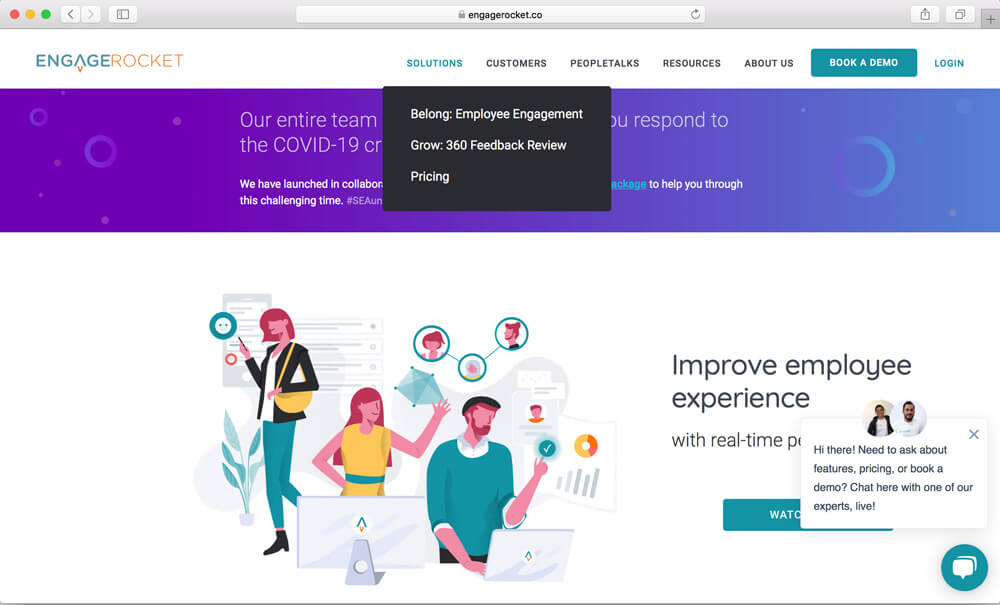By the SMU Social Media Team
Data is the new oil, according to prevailing conventional wisdom. And if you think the tech-enabled analysis of data has no relevance to the very human business of managing people, Dorothy Yiu is here to debunk that notion.
An alumna of Singapore Management University (SMU), Dorothy is the co-founder and Chief Operating Officer of EngageRocket, a local startup launched in 2016 to arm companies with data-driven insights about their human capital (i.e., employees). This field is known as people analytics, and it aims to reduce unwanted attrition and increase workplace productivity through data-driven approaches.
“In many organisations, people are often the most expensive asset and understanding how to effectively manage our talent in a VUCA (volatile, uncertain, complex and ambiguous) environment is increasingly crucial,” remarks Dorothy. In fact, industry insights and audit firm Deloitte recently found that people analytics was the top human capital trend globally. The study also reports that 69 per cent of enterprises larger than 10,000 employees now have a people analytics function.
Dorothy, who holds a double degree in Business Management and Accountancy from SMU, used to be the regional head of a global HR consulting firm, and that’s what kickstarted her entrepreneurial journey, she shares. She felt “ill-equipped” when making decisions based on instinct, and she wasn’t the only one. Dorothy found that almost 60 per cent of the senior leaders she worked with disliked the people management aspect of their jobs, because they felt that it required them to make decisions based on gut feelings, which led to very inconsistent results.
Propelling a different approach
Enter EngageRocket. One of the ways the startup injects big data into the playing field is via ‘pulse surveys’, which helps clients better understand employee sentiments. The surveys involve checking in on employees and customers on a regular basis to measure a company’s operating climate and gauge its performance. Such exercises may be instrumental in improving unwanted attrition and poor productivity through the collection and analysis of employee sentiment data.
“From the data, we can understand what are the drivers of employee engagement so that managers can divert attention and resources to the right areas in order to raise productivity and retention,” says Dorothy.
“HR and managers will also be better equipped with data to catch early flight risks, especially among top talents, by addressing challenges as and when they arise.”
And such measures have already yielded tangible results for one of Dorothy’s clients, which saw its Employee Net Promoter Score (eNPS)—a concept widely used to measure employee loyalty—almost quadruple despite “massive changes” within the company.
As Dorothy adds: “This is a direct result of using data and focusing their intervention efforts on drivers that were causing disengagement.”
Besides stimulating engagement and productivity, data helps HR personnel to spot potential job-hoppers, especially among “top talents”, and work out solutions for retention.
Nevertheless, convincing business leaders and HR professionals that people analytics is valuable isn’t always easy.
“While it is not hard for people to believe in the importance of making better HR decisions with data, the challenge comes in persuading them that this is a problem that requires immediate attention, and not something organisations can afford to take a ‘wait-and-see’ attitude about,” laments Dorothy.
“Being equipped with the foundational knowledge of accounting and finance was useful in my entrepreneurial journey, especially in the early days when I had to wear multiple hats.”
Data: The future of human capital management
In order to stay ahead of the game and be even more in tune with the dynamic niche of people analytics, EngageRocket uses its own products to manage their employees’ welfare and needs. Dorothy affirms that the company’s overall engagement rate has “consistently tracked at least 20 per cent” above their benchmark.
“The trickiest of all challenges lies in the minds of business leaders and HR professionals,” explains Dorothy.
“Shifting the mindset of some leaders and HR has been a challenge because as humans, we have a natural tendency to be resistant to change.”
Globally, a mere 13 per cent of employees are engaged at work, according to a Gallup poll on the state of the global workplace. This is bad news not just for employees as they typically spend most of their waking hours at work, but also for companies as it represents a significant lost in productivity.
Going forward, Dorothy predicts that people analytics will surge in popularity as it “evolves down the analytics value chain towards predictive analytics and prescriptive analytics”. Using these tools will make recruitment cycles, for example, much more efficient.
“The rise of big data has already made many new tools and processes available to us,” says Dorothy. “More new capabilities will guarantee a quantum leap in scientific rigour for people management in the future.”









